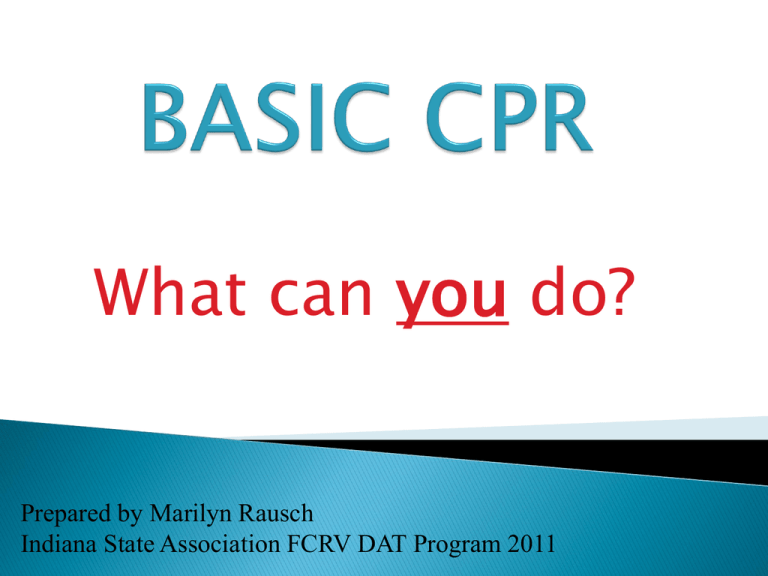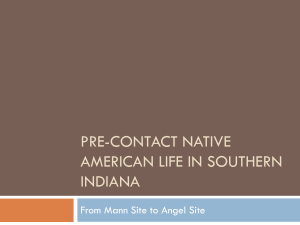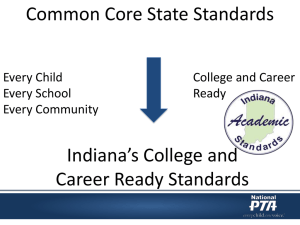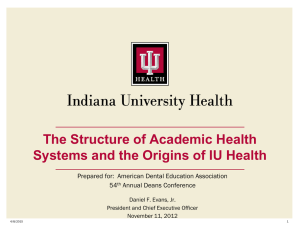BASIC CPR
advertisement

What can you do? Prepared by Marilyn Rausch Indiana State Association FCRV DAT Program 2011 There is NOTHING that you can do that will make the situation worse! To do NOTHING is worse than to do anything at all, even if you do not feel certain of what to do. To be prepared is the best approach Indiana Association FCRV DASAT 2011 This information will not certify you in CPR, but give basic instruction only. There is much more you can learn about choking, use of AEDs, etc. If you want more training in CPR, call 877-242-4277 or your local American Heart Association Indiana Association FCRV DASAT 2011 Compressions-only or hands-only CPR Redefined abnormal breathing Start CPR immediately if person is not breathing normally and not responsive. Reemphasis on decreasing the time lapse between the last chest compression and defibrillation and from defibrillation back to chest compressions. Indiana Association FCRV DASAT 2011 recommended to lay rescuers who are not comfortable giving rescue breaths or have no personal protective equipment when they encounter a person who has had sudden cardiac arrest. Indiana Association FCRV DASAT 2011 The agonal respiration or gasping for breath that is common among cardiac arrest patients is not normal breathing, Calls for emergency response. This is the same action as for a patient that is not breathing at all. Indiana Association FCRV DASAT 2011 the person is not breathing normally the person is not responsive You cannot easily identify whether a person has a definite pulse within 10 seconds Indiana Association FCRV DASAT 2011 Head tilt / chin lift and looking, listening, and feeling for breathing are no longer a first recommended action For a lay responder when responding to a medical emergency. Indiana Association FCRV DASAT 2011 Compressions should be fast and deep ◦ AT LEAST 100 chest compressions per minute ◦ AT LEAST 2 inches deep for an adult. ◦ at least 1/3 the depth of the chest of a child/infant They should allow for full recoil of the chest before the next compression. If an AED (defibrillator) is used, IMMEDIATELY resume chest compressions for 2 minutes. Indiana Association FCRV DASAT 2011 What prevents people from performing CPR when needed? Lawsuits? Good Samaritan Laws protect you those who voluntarily render emergency aid to another individual. Indiana Association FCRV DASAT 2011 What prevents people from performing CPR when needed? Unsure of Skills? Anything is better than nothing. If a person is not breathing, the “numbers” aren’t important. Do something! Indiana Association FCRV DASAT 2011 What prevents people from performing CPR when needed? Might Hurt or Kill Patient? The person is already dead. How much worse can the person become? Since time is of the essence, If you do nothing, there is no chance… Indiana Association FCRV DASAT 2011 What prevents people from performing CPR when needed? Fear of Disease? Hands-Only CPR may be a good alternative if you don't have personal protective equipment or don't feel comfortable giving rescue breaths. Convenient one-use CPR face shields that can be carried in purse or on key chain are available. Latex or vinyl gloves can also be used. Indiana Association FCRV DASAT 2011 What prevents people from performing CPR when needed? Unsafe Scene The most valid fear Do not become another victim yourself. If you're going to enter an area to rescue someone, make sure that the surrounding area is safe enough so that you don't become another victim. Indiana Association FCRV DASAT 2011 helps encourage lay rescuers to get involved who may not otherwise help. Rescuers deliver ◦ 2 inch deep compressions ◦ rate of at least 100 compressions per minute without the need to deliver rescue breaths in between. Hands-only CPR eliminates the fear of transmitting disease by removing the mouth-to-mouth component. Indiana Association FCRV DASAT 2011 ADULT: ages 8 and older. CHILD: ages 1-8 INFANT: ages under 1 year old Indiana Association FCRV DASAT 2011 SEQUENCE For ADULT CPR, activate 911 before starting CPR. For CHILD AND INFANT, activate 911 after 5 cycles (2 minutes) of CPR Indiana Association FCRV DASAT 2011 DEPTH OF COMPRESSION Adult: 1½ to 2 inches. Child and Infant: 1/3 the depth of the chest. Indiana Association FCRV DASAT 2011 POSITION OF HANDS In all ages, place hand mid-chest on an imaginary line between the nipples Adult and Child: use the heel of the hand Infant: use 2 fingers placed over the breastbone. Indiana Association FCRV DASAT 2011 Assess the need. Activate 911. Give 2 breaths (or start hands-only Compressions) Push on chest. Indiana Association FCRV DASAT 2011 If someone seems to have collapsed, check for responsiveness. “ARE YOU OKAY? CAN YOU HEAR ME?” Shout Indiana Association FCRV DASAT 2011 Shout “Somebody help me.” If someone is there, direct them: “Hey, you, call 911 NOW.” If no one is available, leave to call 911 yourself then return to start CPR. Indiana Association FCRV DASAT 2011 Tilt the head and lift the chin Look, listen and feel if there are any signs of breathing. If not, deliver 2 breaths as directed. Indiana Association FCRV DASAT 2011 This is the most important part of CPR. Even if you do not feel comfortable or are unable to do the breathing, at least do this: PUSH FAST AND PUSH HARD Aim for 100 beats/minute (Time yourself to the BeeGees’ song “Staying Alive”) Indiana Association FCRV DASAT 2011 30:2 Thirty pushes to 2 breaths (Or 100 beats/minute if doing hands-only CPR)) RECOGNIZING SERIOUS CONDITIONS AND PROVIDING EARLY TREATMENT MAY HELP PREVENT THE NEED FOR CPR Indiana Association FCRV DASAT 2011 Recognize the problem before the heart stops. sweating difficulty breathing chest pain nausea If you believe someone is having a heart attack, call 911 immediately. sit him or her down reduce the anxiety level by reassurance Indiana Association FCRV DASAT 2011 ◦ healthy diet ◦ regular exercise ◦ managing stress ◦ controlling diabetes ◦ controlling high blood pressure ◦ stop smoking Indiana Association FCRV DASAT 2011 Numbness: usually on one side of body/face Slurred speech Weakness Paralysis on one side of the body Blurred vision or sudden loss of vision Drooping arm or leg Drooped face or dribbling mouth Unsteadiness Confusion speaking or understanding speech ANY OR ALL OF THESE SIGNS MIGHT BE PRESENT Indiana Association FCRV DASAT 2011 If you suspect a stroke: ask the person to “Show me your teeth.” With a stroke there may be a crooked smile. “Close your eyes. Hold both arms out in front of you.” With a stroke, one arm may sag. “Repeat after me: ‘Don’t cry over spilled milk’.” With a stroke, the speech may be garbled. Indiana Association FCRV DASAT 2011 The most common is when a clot blocks an artery that carries blood to the brain. Cerebral Thrombosis or Cerebral Embolism. Treatment to dissolve or remove the clot may prevent long term damage If done early enough. The second most common stroke is a Bleed. This is when a Blood Vessel breaks in the brain. Hemorrhagic Stroke. Immediate surgery to stop the bleeding May be life saving. Indiana Association FCRV DASAT 2011 TIME IS OF THE ESSENCE ◦ Data shows that definitive treatment begun within three hours of the onset of symptoms greatly improves the outlook for victims of a stroke. ◦ Get any person having symptoms to an emergency room IMMEDIATELY, and let the receptionist know that a stroke is suspected. Indiana Association FCRV DASAT 2011 The circulatory system fails to deliver enough oxygen to the body tissues. Indiana Association FCRV DASAT 2011 restlessness shivering rapid breathing and pulse rate sweating nausea and/or vomiting headache Tiredness Victim may become unresponsive and lose consciousness. Indiana Association FCRV DASAT 2011 HYPOVOLEMIC (blood loss, dehydration) CARDIOGENIC (heart not pumping well) DISTRIBUTIVE (blood not going where needed) ◦ SEPTIC (infection) ◦ ANAPHYLAXIS (allergy) ◦ NEUROGENIC (trauma to spinal cord) OBSTRUCTIVE (something blocks the blood ◦ ◦ ◦ ◦ Heart causes (blood or infection in sac around heart) Tension pneumothorax (collapsed lung) Pulmonary embolism (blood clot blocks flow in lung) Aortic stenosis (blockage of blood flow in aorta) Indiana Association FCRV DASAT 2011 SHOCK what to do WHATEVER THE CAUSE Elevate the legs higher than the waist. Call 911 Look for things you can change: If not breathing or heart not beating, provide CPR. If bleeding, put pressure on the wound. If chilling, provide blankets If overheated, apply ice compresses to groin and armpits Indiana Association FCRV DASAT 2011 IN CASE OF EMERGENCY YOU May be the only person between survival and death of another person. To provide the best chance of survival REMAIN CALM Panic breeds panic and nothing more DO SOMETHING Anything is better than nothing. Indiana Association FCRV DASAT 2011 IN CASE OF EMERGENCY The best action is PRO-ACTION Take CPR training To be as prepared as possible Indiana Association FCRV DASAT 2011 The End Or, maybe, Just the beginning! Indiana Association FCRV DASAT 2011






